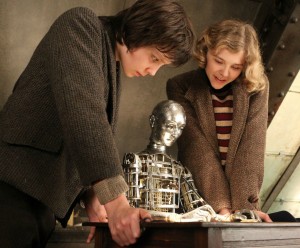Talk about unexpected.
Yesterday, good fiend Tom Hanks and I went to see the new Martin Scorsese film, Hugo.
Based on the children’s book The Invention of Hugo Cabret, the story centers around an orphaned son of a clock maker who lives secretly within the walls of the clock towers in a busy 1930s Paris train station. He keeps the clocks running during the day, and by night, works to solve a mystery — one directly tied to the father he misses so much — locked inside a non-functioning automaton his dad found rotting in a museum.
This is not a children’s film, in that there are no blazing special effects (although the CG and 3D were masterfully done), and actually very little extended dialogue. Things are left for the viewer to discover; to experience; to pull from the tale’s framework. It is a touching, moving and tender story of a sad little boy with a heart full of love and a penchant for adventure, and no one to share it with, until that one day…
The casting, typical of Scorsese, is flawless. The child actors are completely effective: no pandering or becoming tiresome. The somewhat sparse script, while a bit slow to start, wastes not a single word. Ben Kingsley, Sacha Baron Cohen and Christopher Lee are brilliantly believable. The colors in the cinematography are not to be believed, however. Seriously, the photography will knock you out. The only way to drive that point home is to provide some stills, taken from the movie’s website:
~
You simply must see this film. Not only is it cinegraphically (is that a word?) and verbally beautiful, but there’s a fantastic side-story surprise buried about halfway through, in the form of a delightfully entertaining, visually stunning history of filmmaking and film preservation — a subject near and dear to Scorsese’s heart.
On the Rat-O-Meter scale of five cheeses, I give Hugo:

Great movie, great company, great afternoon. Done and done.
Now it’s on to the insanity of the next 72 hours. We shall overcome……………………..
FO







Agreed on everything….great film.
One point…I think you are right about the splendor of the cinematography…and the stills you linked do show some of that…however I don’t think they are quite as good as what is actually in the film. This is something that has always bothered me……when films release photos for the press they release shots taken by the on set photographer…not actual still frames captured from the film itself. To me there is a noticeable difference…even if they try to emulate the color and look of the film.
I think its cool you posted those…because they do give a good idea of the film…but I just thought I would mention it as it has always been something that distracts me. Nine times out of ten the stills released are not be actual frames from the movie…be it online or in magazines…etc. I am not quoting any real statistic…but that is my personal opinion from the examples I have seen.
But this was a great film…and it was great seeing it with you. We will have to hit the theater again soon.
and also…its probably worth noting that when I say “film” I don’t mean actual film…. this film was not shot on actual film but was shot digitally since it is much easier to achieve a good 3d effect using digital motion picture cameras. (as far as I know this was scoreseses first venture into digital filmmaking) The on set photographer used a digital camera too no doubt….but the lenses used and the processing the digital motion picture went through would be entirely different.